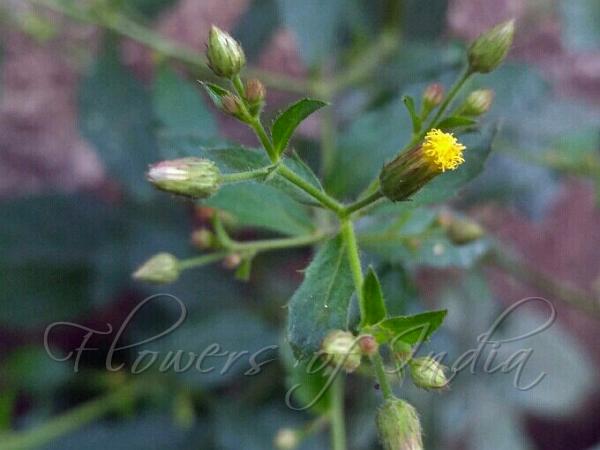|
| Panicled Camphorweed |
|

|

|
|
|
|
Photo: |
Botanical name: Pluchea paniculata Family: Asteraceae (Sunflower family)
Synonyms: Blumea membranacea, Blumea senecioides, Blumea viscosula
Synonyms: Blumea membranacea, Blumea senecioides, Blumea viscosula
Panicled Camphorweed is an annual herb with stems are
simple or branched from base, erect, 0.15-1.5 m tall, hairy
particularly in the younger parts. Leaves are ovate-lanceshaped or
obovate, base tapering, pointed, margins sawtoothed-toothed, 4-18 x 1-6
cm, the upper entire, the lower lyrately lobed, all hairy on both
surfaces. Flower-heads are borne in lax panicles, clustered at the ends
of branches, 5-8 mm in diameter, flower-cluster-stalk hairy, glandular,
up to 3 cm long. Involucral bracts are pruplish-tinged, slightly longer
than florets, linear, 1-9 mm, velvet-hairy, reflexed, inner with
scarious margins. Receptacle is flat or slightly convex, alveolate,
glarbous. Flowers of bisexual florets are yellow, tubular, 4-6 mm long,
5-lobed; lobes pointed, velvet-hairy; flowers of female florets are
thread-like, 4-5 mm long, 2-3 -lobed, hairless. Seed-pods are brown,
oblong, ribbed, velvet-hairy. Pappus white, up to 5 mm long. Panicled
Camphorweed is found in forests, valleys along streams in the
Himalayas, at altitudes of 300-1400 m. It is also found in South India,
Sri Lanka and SE Asia. Flowering: February-June.
| Identification credit: Maniruddin Dhabak | Photographed in |
• Is this flower misidentified? If yes,